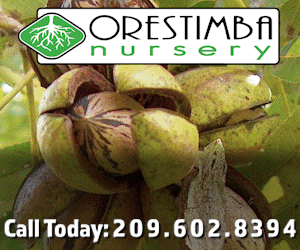
Diluting poor-quality groundwater with surface water, planting to tolerant rootstocks and applying the water leaching fraction method at the end of the season are three ways to manage almond orchards with salinity issues. This year’s drought and subsequent reduction of available surface irrigation water in many districts have compounded the salinity issue and presents challenges for growers.
Salt burn is a visual symptom exhibited by almond trees affected by high levels of salts in soil and irrigation water. It usually is evident late in the summer. Tissue analysis of affected leaves can determine if the dried and crispy leaf tips and edges are caused by high levels of salt in irrigation water. Almond leaf scorch, a disease, can cause similar symptoms, but not all trees in the orchard will be affected. An orchard with salt burn will exhibit poor growth. Leaf sampling in mid-July can be compared to UC critical values to determine the relative level of salt. Once it is obvious that salt burn is affecting trees, next year’s production will be affected.
Sebastian Saa, Almond Board of California’s Director of Agriculture Research, said salinity in California agriculture is an ongoing challenge for growers. Groundwater in parts of the San Joaquin Valley can have high levels of sodium and chloride. Drought exacerbates the problem as the concentration of salts increases without dilution from rainwater or delivered good-quality (low-salinity) surface water.
Salt burn occurs when salts are absorbed by the tree roots and accumulate in the tree leaves. Over time, the affected area may extend further up the leaf with the entire leaf being brown and crispy. While the current year’s production may not be affected, over time yields will drop. Salt burn reduces tree growth and affects fruit set for the next season due to lack of tree reserves for spur development.
Saa said testing irrigation water for salt levels helps growers know if remediation is needed.
To manage high salinity levels, a second source of water can be used to dilute poor groundwater. Also, leaching salts down past the root zone can be done by applying the leaching fraction method by the end of the growing season.
Long-term, Saa said, use of salt-tolerant rootstocks may be the way to go.
“If you have a tolerant rootstock, this will help a lot” Saa said. In his observations, in general the peach hybrid rootstocks exhibit the most tolerance to a high-salt environment.











